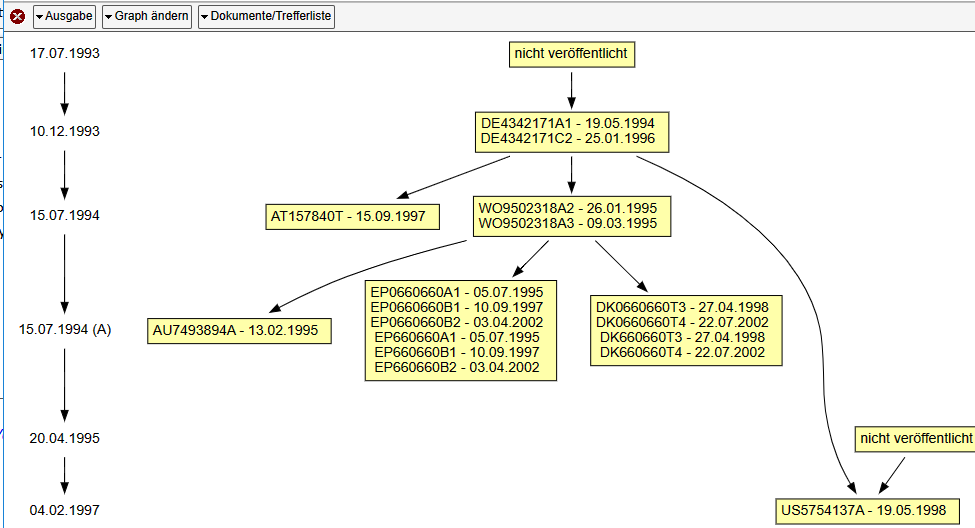Information and explanations about patent family
If an invention is made for which a patent application is to be filed, this may subsequently be done in several countries, depending
on the countries in which market opportunities are expected for a product that is to be marketed in whole or in part with features protected by the patent.
Since the patent right is a territorial right, it is necessary to apply for a patent in each country where the product is to be protected later. So these
patent documents are somehow related to each other, since they are based in whole or in part on the same invention. This also applies if a utility model,
which is subject to less stringent examination, is also filed from the patent application. One of the explanations of the European Patent Office on its
website:
"A patent family is a group of patent applications covering the same or similar technical content."
Priorities
In this case, the documents are necessarily linked to each other via their priorities. This results as follows: First, a patent
application is filed in a country. This is the so-called first application (priority application). If further applications are filed in other countries
with reference to the so-called first application, these are referred to as subsequent applications. These subsequent applications formally claim the
same seniority as the first application, the so-called priority application. This is only possible if the subsequently filed applications are identical
or very similar in content to the first application.
Why is it done this way? If one wants to obtain a patent (not only to apply for it, but to obtain an actually granted property right and only this
develops a protective effect), the Office will check whether there is not already prior art (so to speak published knowledge before the application)
which contradicts the granting, because it would be assumed that the inventor was able to copy from the already existing knowledge and thus did not
invent anything new at all. Information available up to the filing date of this first application is taken into account. A subsequent application
which claims this priority application therefore refers to this filing date of the first application. Thus, only prior art that existed up to the
filing date of the priority document can be invoked against this subsequent application. After the priority period has expired, an application can
no longer claim this priority. On the contrary, the first application would even constitute prior art which could be held against this document to
be filed subsequently as being detrimental to novelty.
Strict and extended patent family
The information shows that the patent family always refers to documents which refer to the same priority document, i.e. the
first application. This forms the so-called strict patent family.
But now there are documents that want to protect further technology in addition to the technical content of the initial application. This can even happen
in one and the same state. Thus, if a subsequent application refers to two priority documents or if the subsequent application itself is again a priority
document, this results in an extended patent family whose technical content is no longer identical but at least very similar. Several priorities then
form a so-called extended patent family.
In XPAT we work with the extended patent family. Often the term "patent family member" is used as something synonymous to the original document. But
beware, it is always the claims of the documents to be protected or actually protected that are decisive. These may well be different within the same
family.

The term patent line used in XPAT
In XPAT we also use the term patent line, which are marked in the family overview by color change. If we take as an example the document
or the patent family to DE4342171:
The patent family is as follows:
- EP0660660 (A1)
- EP0660660 (B1)
- EP0660660 (B2)
- AT157840 (T)
- AU7493894 (A)
- DE4342171 (A1)
- DE4342171 (C2)
- DK0660660 (T3)
- DK0660660 (T4)
- US5754137 (A)
- WO9502318 (A2)
- WO9502318 (A3)
- EP0660660 (A1), EP0660660 (B1), EP0660660 (B2)
- DE4342171 (A1), DE4342171 (C2)
- WO9502318 (A2), WO9502318 (A3)
- DK0660660 (T3), DK0660660 (T4)
- The other documents, each represented only once, also represent patent lines but have only one document.
- US5754137 (A)
- AT157840 (T)
- AU7493894 (A)
Attention: different databases may use different definitions of a patent family. The term "patent family" has no legal or legally binding meaning. Likewise, it is possible that there is more than one patent line in an extended patent family from one state.
Patent family oriented databases carry risks that should be known
The often observed attitude that all patent family members are somehow "the same" is very problematic from our point of view.
As much as the merging of patent families in a data set in a database is seen with pleasure, it also involves dangers. These dangers arise from
the fact that the patent claims of two patent family members need not be identical and often enough are not. If one searches for concrete facts
and does not find a family, because e.g. the leading family document in this database does not show this concrete fact, one could be shipwrecked
here with the search.
In XPAT, on the other hand, each document is stored individually in its own data record. If the user is bothered by the fact that he might receive
several documents of a patent family as search results, he can reduce these families in the hit list to one document of his choice by pressing a
button. If he then looks at this document, he can in turn look at each individual family member. This is a very good compromise and such research
traps are thus excluded. There are also interesting visualizations of patent families.

